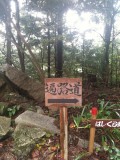 After our bus dropped us at Tokushima station in the evening we spent the night at a henro-oriented guesthouse in Naruto (located very close to temple #1). The pouring rain and remote location put a serious damper on our initial ambitions to go explore the local izakaya life and we had to settle for the rather mediocre chain izakaya our taxi took us to. It was a reasonably early night. Good thing too, as our host gently kicked us out at 9:30am the next day (he apparently had to be somewhere and I guess he wanted to see us off before).
After our bus dropped us at Tokushima station in the evening we spent the night at a henro-oriented guesthouse in Naruto (located very close to temple #1). The pouring rain and remote location put a serious damper on our initial ambitions to go explore the local izakaya life and we had to settle for the rather mediocre chain izakaya our taxi took us to. It was a reasonably early night. Good thing too, as our host gently kicked us out at 9:30am the next day (he apparently had to be somewhere and I guess he wanted to see us off before).
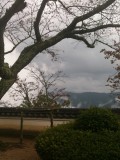 Waiting for the once-every-couple-hours train to Awa Ikeda gave us time to purchase and eat some basic breakfast on the side of the street… Prompting a local obāchan to come running to us, urgently asking for Sona’s help with her needles; twenty thread-through-needle-eye and much effusive thanks later, we were on our way toward the centre of Shikoku by train.
Waiting for the once-every-couple-hours train to Awa Ikeda gave us time to purchase and eat some basic breakfast on the side of the street… Prompting a local obāchan to come running to us, urgently asking for Sona’s help with her needles; twenty thread-through-needle-eye and much effusive thanks later, we were on our way toward the centre of Shikoku by train.
It took less than half-an-hour for the landscape to change from suburban Tokushima-shi concrete, into farm fields and small villages, into just mountains and the odd farm. By the time we arrived in Miyoshi-shi, the stations were little more than platforms in the middle of nowhere.
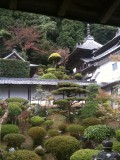 After stocking on local maps, pamphlets and making our reservations for the bus tour on the next day, we trekked across more local train lines, to nearby Hashikura, where a ropeway took us to its namesake mountain-top temple.
After stocking on local maps, pamphlets and making our reservations for the bus tour on the next day, we trekked across more local train lines, to nearby Hashikura, where a ropeway took us to its namesake mountain-top temple.
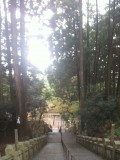 As its name lets on, Hashikura temple (箸蔵時) has special ties to chopsticks (箸). The kanji appears all over the place: on statues, on facades, on monk robes. A very friendly monk manning a small souvenir/incense booth kindly explained that chopsticks, along with needle (針) and brush (筆), were the three most essential items of traditional Japanese life, yet people never pay much care to any of them and discard them without a thought once they are used up. The temple is therefore dedicated to this small and nonetheless essential element of daily life: every year, thousands of discarded wooden chopsticks are gathered, hauled up the (very high) stairs to the temple and burnt in a religious ceremony.
As its name lets on, Hashikura temple (箸蔵時) has special ties to chopsticks (箸). The kanji appears all over the place: on statues, on facades, on monk robes. A very friendly monk manning a small souvenir/incense booth kindly explained that chopsticks, along with needle (針) and brush (筆), were the three most essential items of traditional Japanese life, yet people never pay much care to any of them and discard them without a thought once they are used up. The temple is therefore dedicated to this small and nonetheless essential element of daily life: every year, thousands of discarded wooden chopsticks are gathered, hauled up the (very high) stairs to the temple and burnt in a religious ceremony. 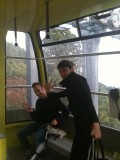
The temple itself was just your nice typical Japanese temple (yes: living in Kyoto makes you quite jaded about these things), with nice surroundings and the added cool factor of climbing a stairway through clouds to get to it.
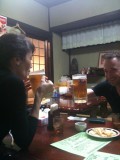
On the way back from the temple, we went exploring the neighbouring villages (more exactly: took some local train in the wrong direction and decided to see where that would lead us), taking the sights in Kotohira, before the rain forced us to take refuge in a local izakaya. There, we finally proceeded to have our true-to-form drinking-with-the-local-country-folk experience: after ordering our ‘large’ beers, which, it turns out, came in glasses roughly the size of a pitcher, we were quickly approached by the regulars: curious to know what three foreigners might be doing there, congratulating our efforts at the local idiom, shamelessly flirting with Sona (nevermind the 50 year age gap) and buying us drink after drink (while we were still fighting to finish aforementioned pitcher-glasses).
Finally, we made our way back to Awa Ikeda (on a completely empty train) where our host, Ueda-san was waiting to drive us to her farm…